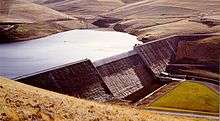Gravity dam

A gravity dam is a dam constructed from concrete or stone masonry and designed to hold back water by primarily utilizing the weight of the material alone to resist the horizontal pressure of water pushing against it. Gravity dams are designed so that each section of the dam is stable, independent of any other dam section.[1][2]
Gravity dams generally require stiff rock foundations of high bearing strength (slightly weathered to fresh); although they have been built on soil foundations in rare cases. The bearing strength of the foundation limits the allowable position of the resultant which influences the overall stability. Also, the stiff nature of the gravity dam structure is unforgiving to differential foundation settlement, which can induce cracking of the dam structure.
Gravity dams provide some advantages over embankment dams. The main advantage is that they can tolerate minor over-topping flows as the concrete is resistant to scouring. This reduces the requirements for a cofferdam during construction and the sizing of the spillway. Large overtopping flows are still a problem, as they can scour the foundations if not accounted for in the design. A disadvantage of gravity dams is that due to their large footprint, they are susceptible to uplift pressures which act as a de-stabilising force. Uplift pressures (buoyancy) can be reduced by internal and foundation drainage systems which reduces the pressures.
During construction, the setting concrete produces an exothermic reaction. This heat expands the plastic concrete and can take up to several decades to cool. When cooling, the concrete is in a stiff state and is susceptible to cracking. It is the designers' task to ensure this doesn't occur.
The most common classification of gravity dams is by the materials composing the structure:
- Concrete dams include
- mass concrete dams, made of:
- conventional concrete: Dworshak Dam, Grand Coulee Dam, Three Gorges Dam
- Roller-Compacted Concrete (RCC): Willow Creek Dam (Oregon), Upper Stillwater Dam
- masonry: Pathfinder Dam, Cheesman Dam
- hollow gravity dams, made of reinforced concrete: Braddock Dam
- mass concrete dams, made of:
Composite dams are a combination of concrete and embankment dams. Construction materials of composite dams are the same used for concrete and embankment dams.
Gravity dams can be classified by plan (shape):
- Most gravity dams are straight (Grand Coulee Dam).
- Some masonry and concrete gravity dams have the dam axis curved (Shasta Dam, Cheesman Dam) to add stability through arch action.[3]
Gravity dams can be classified with respect to their structural height:
- Low, up to 100 feet.
- Medium high, between 100 and 300 feet.
- High, over 300 feet.
References
- ↑ Design of Gravity Dams, Bureau of Reclamation, 1976 Archived January 21, 2012, at the Wayback Machine.
- ↑ Design of Small Dams, Bureau of Reclamation, 2004 Archived February 22, 2014, at the Wayback Machine.
- ↑ Gravity Dam Design, US Army Corps of Engineers, EM 1110-2-2200, June 1995 Archived March 1, 2013, at the Wayback Machine.
Bibliography
- Kollgaardand, E.B.; Chadwick, W.L. (1988). Development of Dam Engineering in the United States. US Committee of the International Commission on Large Dams.
- Dams of the United States - Pictorial display of Landmark Dams. Denver, Colorado: US Society on Dams. 2013.